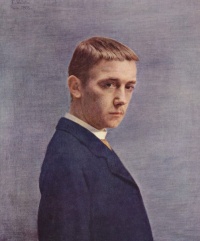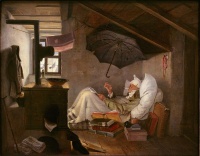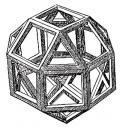Artist
From The Art and Popular Culture Encyclopedia

.jpg)

|
Related e |
|
Featured: |
The definition of an artist is wide-ranging and covers a broad spectrum of activities to do with creating art, practicing the arts and/or demonstrating an art. Debate, both historical and present day, suggests that defining the concept of an artist will continue to be difficult.
Contents |
History of the term
Although the Greek word "techně" is often mistranslated as "art," it actually implies mastery of any sort of craft. The Latin-derived form of the word is "tecnicus", from which the English words technique, technology, technical are derived.
In Greek culture each of the nine Muses oversaw a different field of human creation:
- Calliope (the 'beautiful of speech'): chief of the muses and muse of epic or heroic poetry
- Clio (the 'glorious one'): muse of history
- Erato (the 'amorous one'): muse of love or erotic poetry, lyrics, and marriage songs
- Euterpe (the 'well-pleasing'): muse of music and lyric poetry
- Melpomene (the 'chanting one'): muse of tragedy
- Polyhymnia or Polymnia (the '[singer] of many hymns'): muse of sacred song, oratory, lyric, singing and rhetoric
- Terpsichore (the '[one who] delights in dance'): muse of choral song and dance
- Thalia (the 'blossoming one'): muse of comedy and bucolic poetry
- Urania (the 'celestial one'): muse of astronomy
No muse was identified with the visual arts of painting and sculpture. In ancient Greece sculptors and painters were held in low regard, somewhere between freemen and slaves, their work regarded as mere manual labour.
The word art is derived from the Latin "ars", which, although literally defined means, "skill method" or "technique", holds a connotation of beauty.
During the Middle Ages the word artist already existed in some countries such as Italy, but the meaning was something resembling craftsman, while the word artesan was still unknown. An artist was someone able to do a work better than others, so the skilled excellency was underlined, rather than the activity field. In this period some "artisanal" products (such as textiles) were much more precious and expensive than paintings or sculptures.
The first division into major and minor arts dates back to Leon Battista Alberti's works (De re aedificatoria, De statua, De pictura), focusing the importance of intellectual skills of the artist rather than the manual skills (even if in other forms of art there was a project behind).
With the Academies in Europe (second half of 16th century) the gap between fine and applied arts was definitely set.
Many contemporary definitions of "artist" and "art" are highly contingent on culture, resisting aesthetic prescription, in much the same way that the features constituting beauty and the beautiful, cannot be standardized easily without corruption into kitsch.
The present day concept of an 'artist'
Artist is a descriptive term applied to a person who engages in an activity deemed to be an art. An artist also may be defined unofficially as "a person who expresses him- or herself through a medium". The word is also used in a qualitative sense of, a person creative in, innovative in, or adept at, an artistic practice.
Most often, the term describes those who create within a context of the fine arts or 'high culture', activities such as drawing, painting, sculpture, acting, dancing, writing, filmmaking, photography, and music—people who use imagination, talent, or skill to create works that may be judged to have an aesthetic value. Art historians and critics define artists as those who produce art within a recognized or recognizable discipline. Contrasting terms for highly-skilled workers in media in the applied arts or decorative arts include artisan, craftsman, and specialized terms such as potter or goldsmith. Fine arts artists such as painters succeeded in the Renaissance in raising their status, formerly similar to these workers, to a decisively higher level, but in the 20th century the distinction became rather less relevant .
The term may be also used loosely or metaphorically to denote highly skilled people in any non-"art" activities, as well— law, medicine, mechanics, or mathematics, for example.
Often, discussions on the subject focus on the differences among "artist" and "technician", "entertainer" and "artisan", "fine art" and "applied art", or what constitutes art and what does not. The French word artiste (which in French, simply means "artist") has been imported into the English language where it means a performer (frequently in Music Hall or Vaudeville). Use of the word "artiste" can also be a pejorative term.
The English word 'artiste' has thus, a narrower range of meaning than the word 'artiste' in French.
Examples of art and artists
- Abstract Art: Wassily Kandinsky
- Abstract expressionism: Jackson Pollock
- Actress: Greta Garbo
- Animation: Walt Disney
- Appropriation artist: Marcel Duchamp
- Architect: I.M. Pei
- Art Deco: Erté
- Art Nouveau: Louis Comfort Tiffany
- Ballet: Margot Fonteyn
- Baroque Art: Caravaggio
- Ceramic art: Grayson Perry
- Choreographer: Martha Graham
- Collage: Joseph Cornell
- Colorist: Josef Albers
- Comics: Will Eisner
- Composer: Giuseppe Verdi
- Conceptual art: Sol LeWitt
- Cubism: Pablo Picasso
- Dada: Man Ray
- Dancer: Isadora Duncan
- Designer: Arne Jacobsen
- Expressionism: Edvard Munch
- Fashion designer: Yves Saint Laurent
- Fauvist: Henri Matisse
- Fluxus: George Maciunas
- Game designer: Fumito Ueda
- Geometric abstraction: Piet Mondrian
- Genius: Leonardo da Vinci
- Graphic designer: Milton Glaser
- Horticulture: André le Nôtre
- Illustrator: Gustave Doré
- Impressionist: Claude Monet
- Industrial designer: Frank Lloyd Wright
- Installation art: Christo and Jeanne-Claude
- Jewelry: Fabergé
- Landscape architect: Frederick Law Olmsted
- Minimalist artist: Donald Judd
- Movie director: Andrei Tarkovsky
- Muralist: Diego Rivera
- Musician: John Lennon
- Novelist: Charles Dickens
- Op Art; Bridget Riley
- Orator: Cicero
- Outsider artist: Howard Finster
- Painter: Rembrandt van Rijn
- Performance Art: Carolee Schneemann
- Photographer: Ansel Adams
- Pianist: Glenn Gould
- Playwright: William Shakespeare
- Poet: Pablo Neruda
- Pointillism: Georges Seurat
- Pop Art: Andy Warhol
- Poster-maker: Henri de Toulouse-Lautrec
- Post-Impressionism: Vincent van Gogh
- Potter: Josiah Wedgwood
- Printmaker: Albrecht Dürer
- Renaissance art: Michelangelo Buonarotti
- Rococo: Antoine Watteau
- Sculptor: Auguste Rodin
- Singer: Maria Callas
- Songwriter: Bob Dylan
- Street Art: Banksy
- Surrealism: Salvador Dalí
- Typographer: Eric Gill
- Ukiyo-e: Hokusai
See also
- Artistic inspiration
- Artistism
- Genius
- Patronage
- Romanticism
- Starving artist
- Tortured artist
- Artworld economics
- Posthumous recognition


